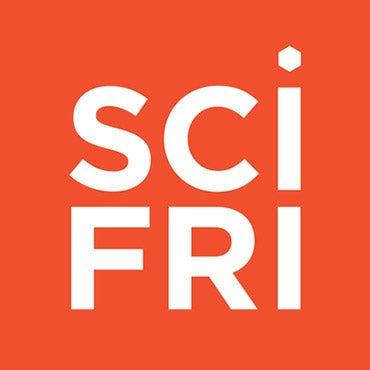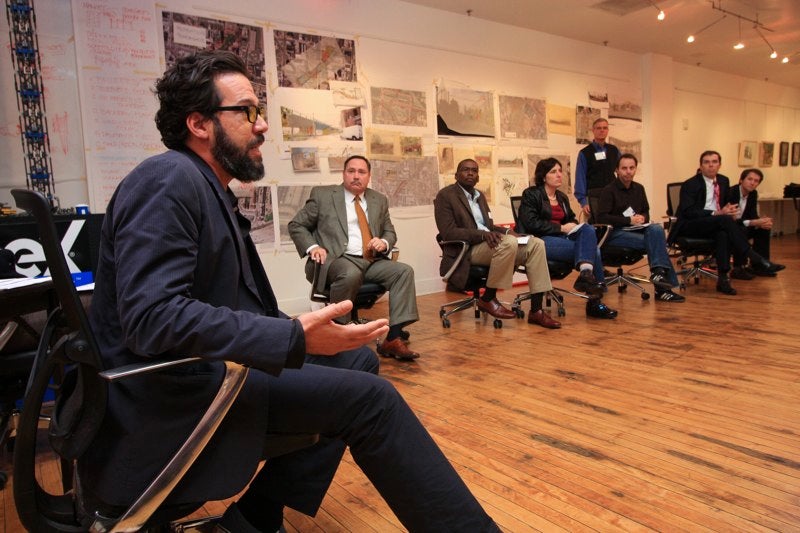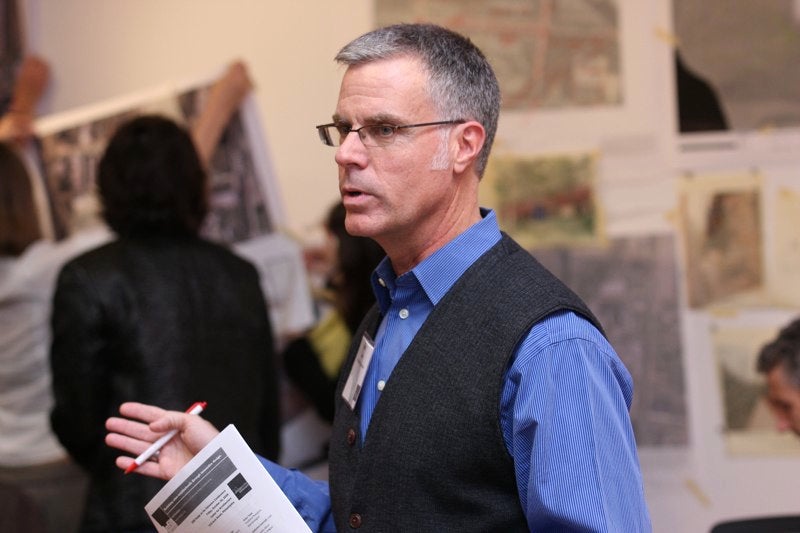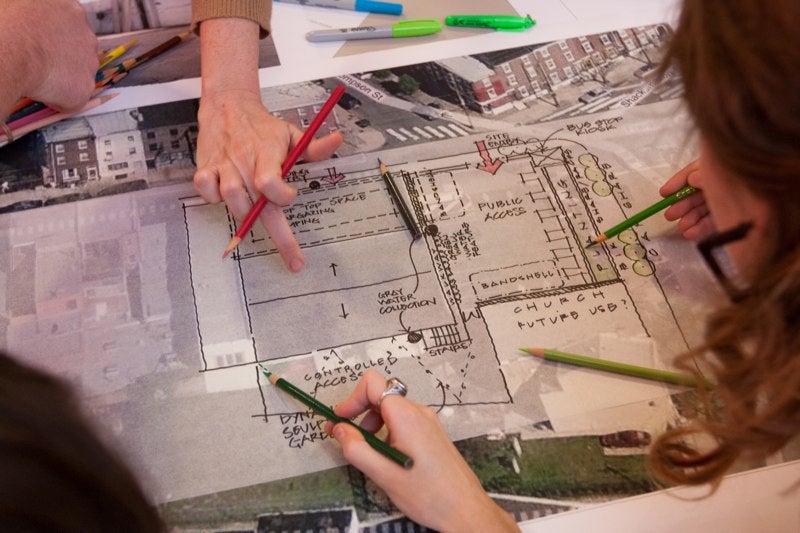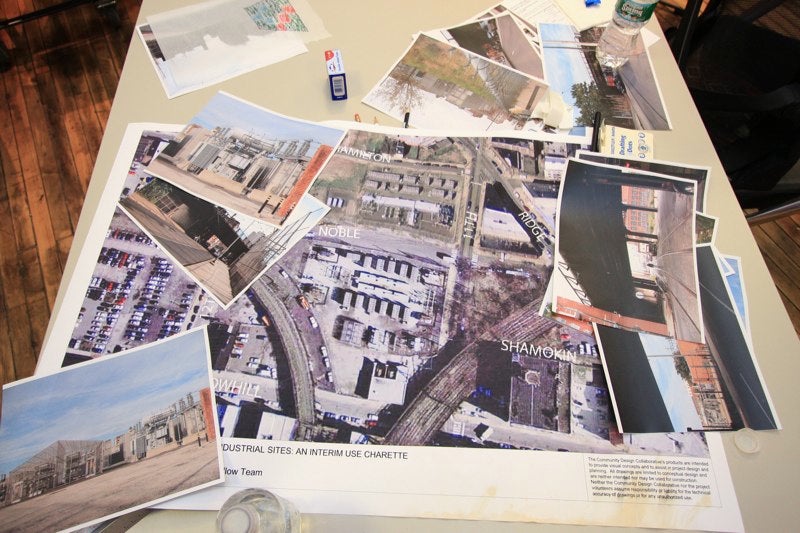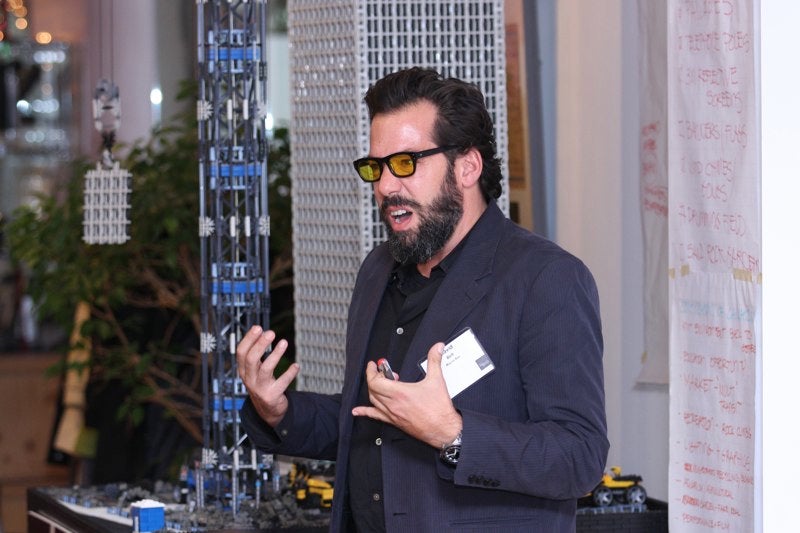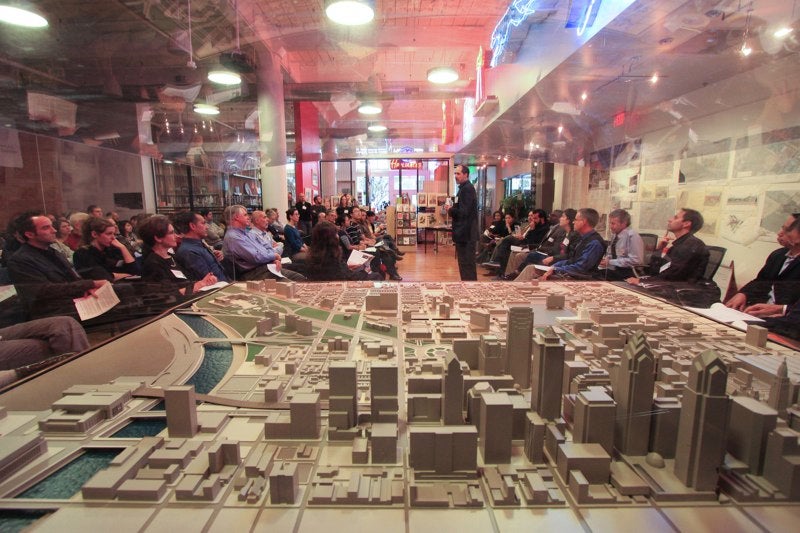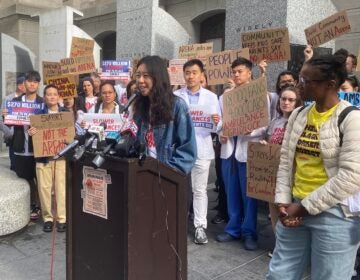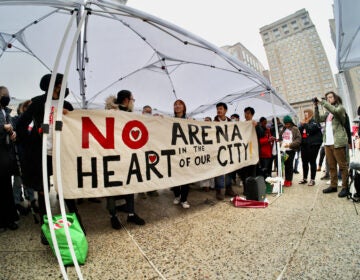Infill Philadelphia: Boldness redefines ‘community center’
Photos courtesy of http://www.MarkGarvinPhoto.com
Nov. 4
By Thomas J. Walsh
For PlanPhilly
Planners, designers and architects attending a day-long design charrette last Friday did not need to be told to be creative, and adapt, when it comes to the short-term re-use of vacant, urban industrial sites – of which Philadelphia has more than its share.
They probably didn’t need any nudges in the direction of going green with their approaches, or to be bold.
From an inspiring guest speaker and critic, though, they just might have gotten a new take on an old saw for a valuable take-away lesson: “It’s a lot easier to ask for forgiveness than it is to ask for permission.”
That was the advice of David Belt, president of the New York-based design firm Macro Sea and one of the guys behind Brooklyn’s celebrated dumpster swimming pools. His work has made him something of a specialist at taking old, wasted spaces and things and rendering them into “fully utilized places of recreation and culture.” Currently, he and his colleagues are looking at ways to transform strip malls in New Orleans, with an eye toward making the results, if successful, into national models.
The charrette’s organizer was Center City’s Community Design Collaborative, in cooperation with other Philadelphia public and private organizations.
“Also, what else is there really to do?” Belt said. Throughout the two-hour, end-of-day review and critique of the participants’ work, the bearded, bespectacled designer channeled the successful Nike ads of recent years, repeating, “I think you should just do it, man.”
Make some little plans
Focusing on specific areas and sites in Chinatown and Kensington, the CDC collaborated with community groups from those neighborhoods as well as professionals from city government agencies. The charrette was part of the CDC’s “Infill Philadelphia” initiative, started in 2007 and now in its third phase, focusing on industrial sites. The day also wrapped up last week’s 7th Annual Design on the Delaware Conference & Trade Show, an American Institute of Architects event held at the downtown Sheraton.
“We all know that we have tens of thousand of acres of vacant sites here in Philadelphia – certainly not all industrial – but they have a big impact on our neighborhoods and on the city overall,” said Rick Sauer, executive director of the Philadelphia Association of Community Development Corporations and a member of the charrette’s organizing committee.
In Chinatown, a planned community center is in the works, but the focus of the sessions was the interim use of that space – the center itself being a couple years away. Likewise in Kensington, Sauer said, plans call for artist spaces and beautification efforts along Frankford Avenue. But in the meantime, what is to be done to create an on-ramp to that kind of development, and to get residents using it?
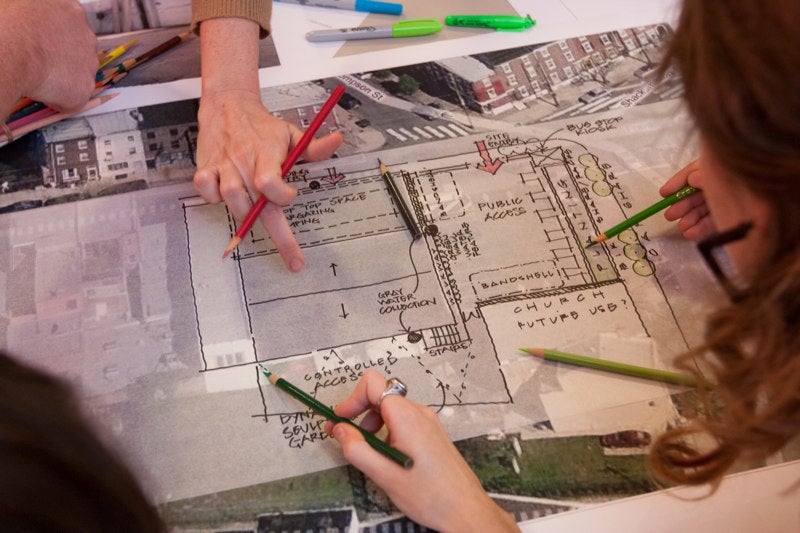
More than a few possible answers were all over the walls behind Sauer, with drawings and penciled-up tracing paper over blown-up maps of intersections in both areas. Some were more practical than others, but the inspiration was to begin the process of spurring even more ideas, which in turn would lead to much-needed economic development and jobs in blighted areas of the city.
Many of those, it is hoped, will be “green jobs,” perhaps even tapping federal stimulus money to kick-start the process. In that sense, a “dynamic sculpture garden” that kids could use interactively for playing – or learning, or both – could lead more directly to an educational or community facility. An “interactive bus shelter” could spur further funding from technological or transportation sources.
Rainwater capture schemes, vine-covered “green walls,” an outdoor band shell or theater, stairs that lead to a rooftop made suitable for stargazing – perhaps even a safe spot for inner-city kids to sleep outside. For an empty interior space, what about a playhouse that could double as an indoor theater and performance space? Old industrial buildings often have lofts and mezzanine levels that are perfect for studios or simply storage spaces for artists. One drawing showed salvaged hanging chair rides from an amusement park inside a cavernous empty space. All were just a few suggestions for interim uses in the two communities.
“I must say I was impressed with the span of ideas that have come out of four hours” of intense brainstorming, said Alan Urek, the City Planning Commission’s director of strategic planning and policy. Complimenting the four charrette teams, Urek said it was important to honestly represent the sites being discussed.
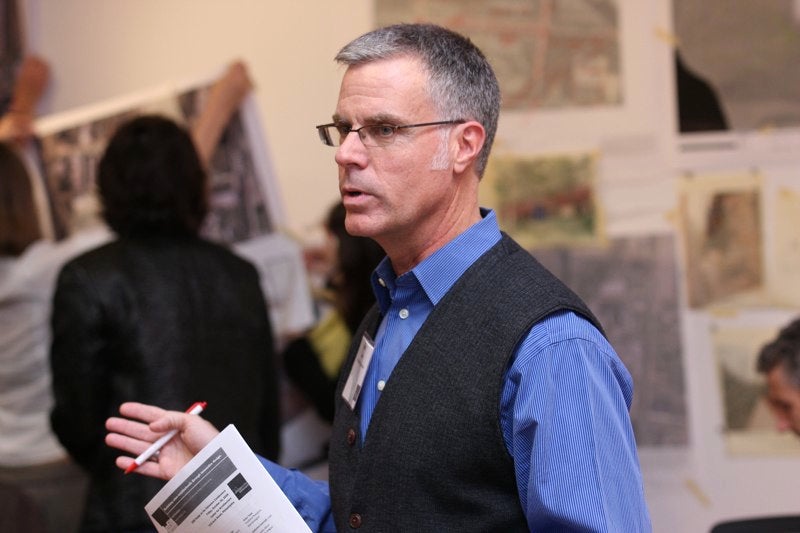
“Every one of these talked in great length about the different kinds of programming that will be required in order to make them happen,” Urek said. That spans from a one-night event to “something that is way beyond temporary.”
Some, of course, were more financially do-able than others. “I know there were cost estimators available to the teams to get an order-of-magnitude idea of what some of these ideas would cost,” Urek said after the event. “But [the charrette] wasn’t designed really to get to that level.”
‘Programming the hell out of it’
The Chinatown Community Center, planned for 10th Street north of Vine Street, which has been a major barrier to development for years, will build on Chinatown’s “traditional mix of ground floor retail with other uses above street level,” according to its designer firm, A K Architecture, which built Lloyd Hall, the community rec center addition to Boathouse Row. But ultimately, it is envisioned as “a new kind of hybrid facility – mixing commercial and public uses in one place.”
In the meantime, though, the neighborhood remains a mix of past and present industry, with a large PECO substation, abandoned warehouses, a tough housing climate, and darkened, sometimes dangerous streets and spaces around and beneath the burdensome sleeping leviathan known as the Reading Viaduct.
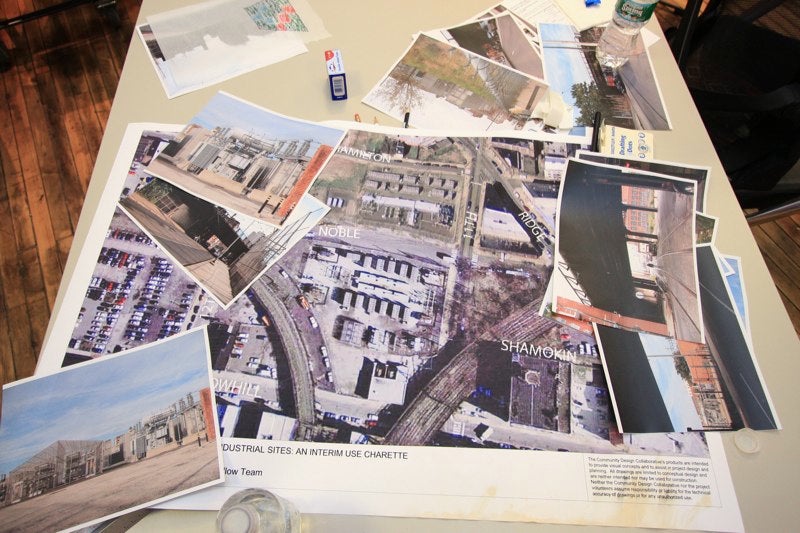
Thoughts for interim uses of those kinds of spaces went toward lighting them up in creative ways, such as a series of “lit scrims,” or using natural elements such as wind and rain – wind chimes or gongs activated by the passing of cars and pedestrians, or water as a “rhythm element.” On some of the many sloped embankments that lead up to the viaduct, used tires could create retaining walls, or terraces, or climbing playgrounds.
Some spaces have no embankments, and instead sport attractive stone walls supporting the abandoned rail lines, which slice diagonally through the neighborhood, creating irregularly shaped parcels. So, what about interchangeable open-air markets? There are places for community gardens, too. Even an apiary was tossed upon the wall (though that idea may literally be too much a case of batting the beehive of the viaduct’s owner, an ancestor of the Reading Railroad, now based in California).
The creativity of the ideas for interim use won much praise and a few suggestions for tweaks, or a re-thinking, from the panel that analyzed the work at the end of the day.
“I think you should light up the dirt,” Belt said about the Chinatown ideas, to some laughter. “Make the ugly pretty.”
Explaining the appeal of highlighting the challenging spaces and showing them for what they are, he said, “I like the idea of a community center without the Community Center. I like the idea of just programming the hell out of it, as if the Community Center exists.”
“You’ve got a place for people to gather, to hang out, and you’ve got stuff going on,” Belt continued. “Just do it. Put up a tent. If there’s social services stuff that has to be set up, put up a temporary structure. Let’s build some shacks or something, to get people to come there. Also Chinatown has such a strong presence of food, and all these amazing restaurants and stuff. I love the idea of tying the sites together, and maybe having some really cool food carts that rotate around. I think some of the local restaurants would really embrace that.”
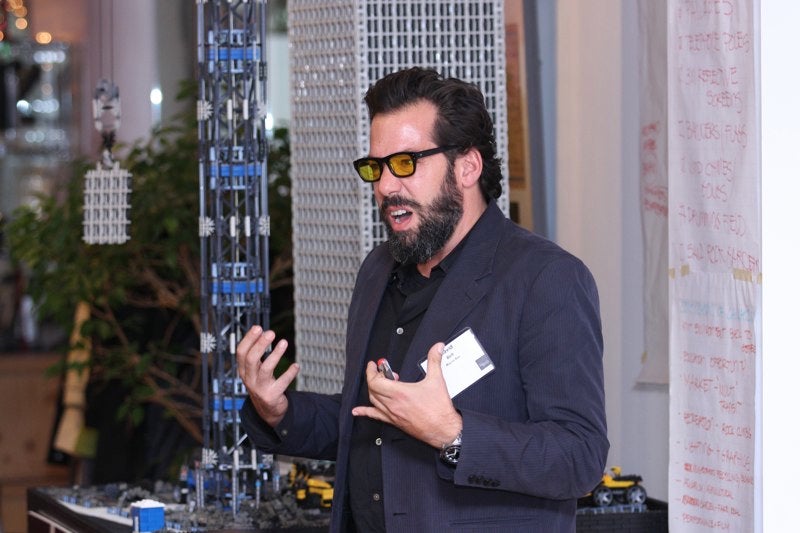
Belt said the participants’ idea of lighting up the PECO station “all crazy cool” was a good one, as well as the notion of taking unsightly fences “broadcasting on them” with color and electronic messaging. And even as he commented on the renderings, he came up with new ideas of his own.
“I really think someone should do an urban archery range,” he said, again to chuckles. “I think that would be really amazing.” That reminded him of someone else’s idea of creating a space to break bottles, perhaps for use in mosaics, or at least to condense glass for recycling. But beyond that, “Why not just make a place where people can go to always break bottles? … I would go there.”
Belt also suggested using spaces that on the surface sound somewhat irreverent, with his “just do it” undercurrent, but which really are basic uses that can easily be temporary. An ice-skating rink, maybe with carefully placed spots for the natural counterpoint to ice – fire (though he didn’t mention it, perhaps in hand-warming steel barrels, Italian Market style?). And outdoor bars, while you’re at it, serving hot toddies.
“Instead of just trying to please everybody, just really go for it as far as you can,” Belt said. Responding to a question toward the end of the session, he answered by further imploring action over ponderousness.
“Why is anything wasted if it only lasts three years? If it transfers consciousness, how you see a space, because you have a significant feeling there, who’s to say that’s a waste? I mean, who cares if you do something and it doesn’t last forever? Everything is pretty much temporary anyway,” Belt said.
“So the idea of scalability, the idea that you’re gonna waste something that prevents you from doing something positive for the community, to bring people together to think about space differently … it’s worth it, even if you waste a little money. Of course you don’t want to waste materials that are going to create pollution or anything, but the idea that everything has to be permanent, that everything is fixed, or, it has to be an industrial space, or a good clean industrial space or it has to be a performing space, I just think that’s nonsense. And that is part of the exercise. … And I just think you should do it, man.”
Brainstorming ideas and focusing on interim solutions “should be a regular occurrence in the city,” said Aaron Levy, executive director of the Slought Foundation, a Philadelphia nonprofit that explores “rejuvenation and reinvention” via cultural and socio-political change. “This should be happening all the time.”
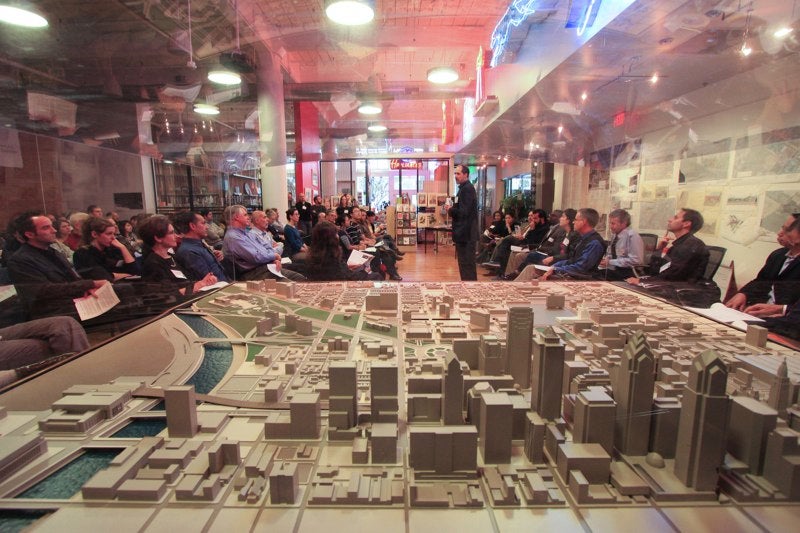
Next up for the Infill Philadelphia initiative is the juried “precedent exhibition” scheduled for February. A call for entries will be made to area architecture, planning and engineering firms for what they’re calling the “Retooling Industrial Sites Exhibition,” showcasing best practices in industrial re-use.
The exhibition will also launch Infill’s third industrial program, a “Design Challenge” that will run through May and feature three volunteer design firms partnering with community groups, developing re-use concepts for “three real-life sites.”
The organization is partnering closely with the Philadelphia Industrial Development Corp., which will soon release its Industrial Market and Land Use Strategy report, which has been more than a year in the making.
Contact the reporter at thomaswalsh1@gmail.com.
ON THE WEB
Community Design Collaborative (CDC): http://www.cdesignc.org/
Infill Philadelphia: http://infillphiladelphia.org/
Macro Sea: http://macro-sea.com/team.asp?teamID=1 (Belt bio)
Philadelphia Chinatown Development Corp.: http://www.chinatown-pcdc.org/
New Kensington Community Development Corp.: http://www.nkcdc.org/
WHYY is your source for fact-based, in-depth journalism and information. As a nonprofit organization, we rely on financial support from readers like you. Please give today.

